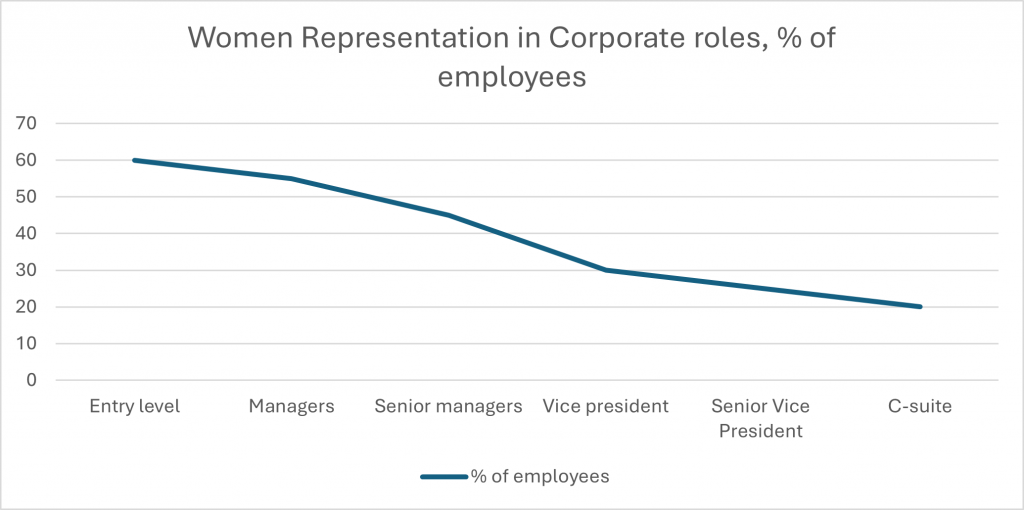McKinsey’s latest report highlights a noteworthy advancement: Over the past decade the number of women breaking through the glass ceiling and stepping into leadership roles has risen significantly, with 29% now occupying C-suite positions, up from just 17% in 2015. This progress marks a pivotal shift, yet it only tells part of the story. Despite these achievements, women continue to be underrepresented in top leadership roles, hindered by entrenched systemic barriers within corporate structures.

Source: Women in the Workplace 2024, Mckinsey and Company
Beneath the surface, a stubborn gender gap remains, especially at the critical entry and manager levels. For many women, the corporate pipeline is still more of a tightrope walk, with men continuing to outnumber them at every stage.
The challenge is deeper than the numbers. Unseen yet powerful forces—often called “second generation” gender bias—continue to shape leadership norms, making it harder for women to be seen as credible leaders. In cultures where leadership is equated with traits traditionally associated with men, women are left navigating a complex web of expectations, often needing to prove themselves twice over. Adding to this, the unconscious habit of men advocating for those who remind them of themselves reinforces the cycle, leaving fewer opportunities for women to rise.
Accordingly, achieving gender parity in leadership is still a distant goal, with current progress far too slow. At this rate, it will take 22 years for White women to reach leadership equality—and more than twice as long for women of colour.
Women in India questing for equal representation
In India, it is widely evident that pervasive unconscious biases and stubborn stereotypes surrounding women’s leadership abilities cast a shadow over their potential, significantly limiting their access to vital mentorship and development opportunities. While Asian women have seen improvements in the initial stages of their career progression, often referred to as the “broken rung,” they still encounter significant hurdles later in the pipeline. Many women also grapple with work-life balance challenges, with 80% taking career breaks, largely due to childcare and homemaking responsibilities. These issues, coupled with a lack of female mentors and limited leadership development programs, widen the confidence gap, making it even harder for women to rise into leadership roles.
Additionally, gender pay disparities and underrepresentation in senior positions complicate the landscape further. Currently, only 10% of Indian women occupy CXO roles, highlighting the systemic barriers that persist. Unfavorable workplace cultures that fail to support diversity often deter women from pursuing leadership positions altogether. This pattern underscores the need for targeted initiatives to address these disparities, promote inclusive work environments, and empower women to navigate their career paths more effectively.
Forging a Future Where Women in Leadership SHINE
Going forward, the path to leadership shouldn’t be a maze of barriers. To create a future where women lead authentically and equally, we must rethink not only who gets to the top but how they get there. By confronting these biases head-on, we can open the door to a new generation of women leaders who are ready to transform the way we work and lead.
In pursuit of empowering women in leadership, cultivating resilience and providing supportive encouragement are essential. Effective training equips them with the vital tools and strategies for success. InspireOne’s SHINE program stands out as a beacon of this mission, empowering women with the knowledge and skills necessary to thrive in leadership roles. By fostering a growth mindset, SHINE encourages participants to view challenges as stepping stones for personal and professional growth. The program not only promotes mentorship and effective influence but also emphasizes enhancing executive presence and developing emotional self-awareness. Participants learn to adeptly regulate their emotions, amplifying their impact and presence in leadership contexts and paving the way for a more equitable future.
Hence, achieving gender parity requires a comprehensive approach and active involvement from all employees. Celebrating progress, even small wins, generates enthusiasm and builds momentum, making a meaningful impact for women in the workplace. Programs like SHINE empower the next generation of female leaders to challenge stereotypes and contribute to a more equitable and sustainable future in leadership.
References:
Armour, H. (2024, May 31). Nurturing Women’s Leadership: Building Strong Foundations. Retrieved from https://www.leadershiptrust.co/insights/nurturing-women-in-leadership/
Ibarra, H. (2019, August 23). Women Rising: The Unseen Barriers. Retrieved from https://hbr.org/2013/09/women-rising-the-unseen-barriers
Krivkovich, A., Field, E., Yee, L., McConnell, M., & Smith, H. (2024, September). Women in the Workplace 2024: The 10th-anniversary report. McKinsey & Company. Retrieved from https://www.mckinsey.com/featured-insights/diversity-and-inclusion/women-in-the-workplace
Majumdar, D. (2024, March 18). There are more women in leadership roles now, but challenges & biases still remain. The Economic Times. Retrieved from https://economictimes.indiatimes.com
People matters – Interstitial site — People matters. (n.d.). Retrieved from https://www.peoplematters.in/article/leadership/women-in-leadership-a-deep-dive-into-the-obstacles-and-the-future-of-equality-39501
The power of Women’s leadership development – Thayer Leadership. (n.d.). Retrieved from https://www.thayerleadership.com/blog/2021/the-power-of-womens-leadership-development







